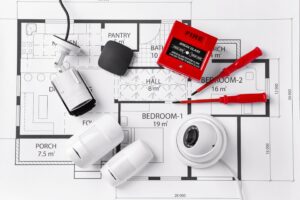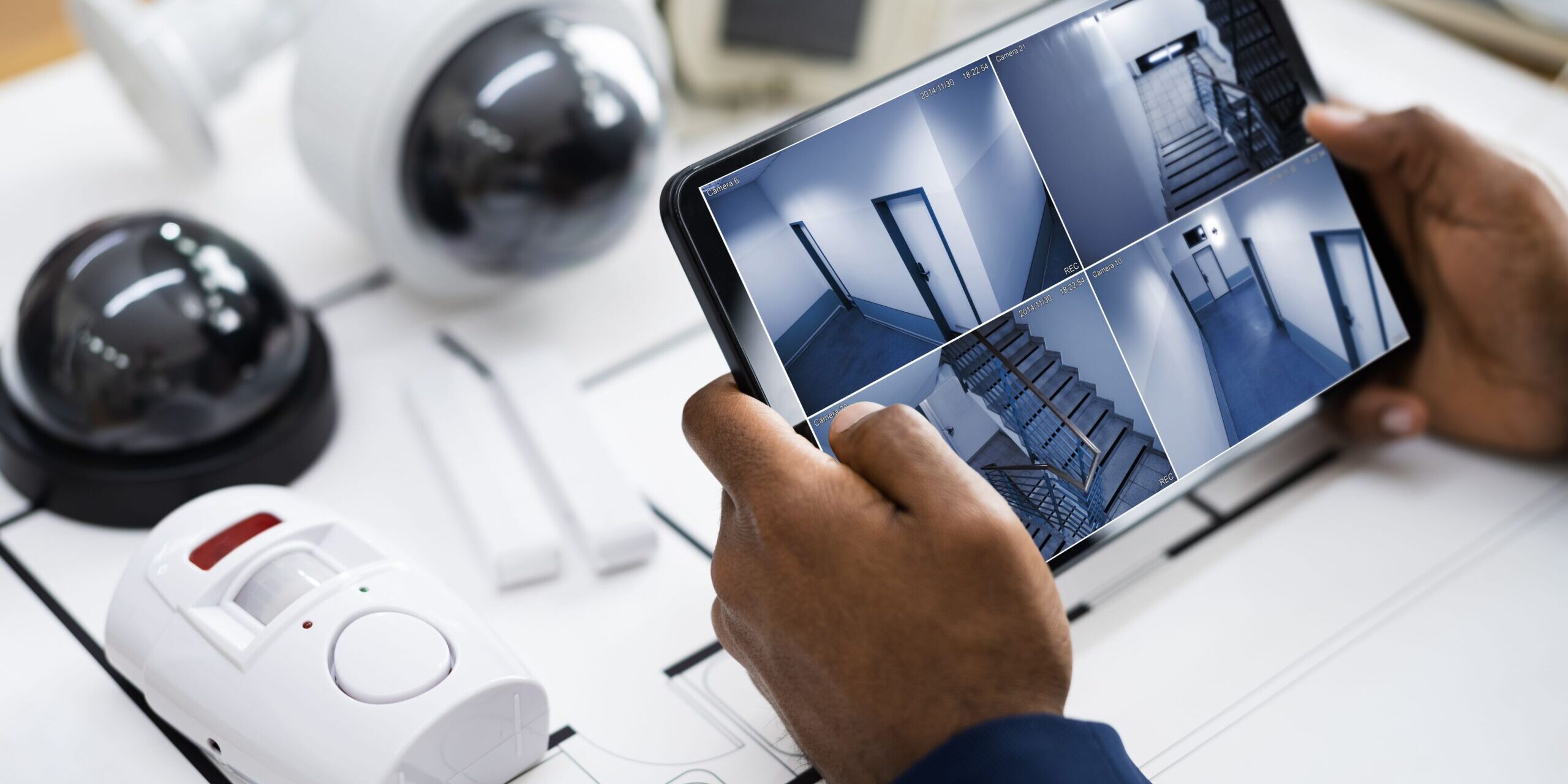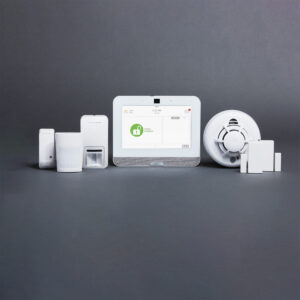Any security system’s name is the most fundamental way to characterize it. It essentially maintains something securely via a system of components and devices that all operate in concert to keep something safe.
What Is a Security System
Here, we’re discussing home security systems and networks of integrated electronic devices with a central control panel to deter would-be thieves and other intruders from entering your home.
Over the past few years, there has been a significant advancement in technology that underpins home security systems. Several wireless security systems are available today. You may also use many of them to manage your home’s lighting and temperature. In other words, you will get more value for your money! They’re also more user-friendly today than a few years ago due to the proliferation of smartphones and touch-screen screens.
This tutorial will show you how security systems function and what they can do. We’ll compare wireless systems to wired systems, look at how they function, which security alarm features are the most significant, and why it’s good to include cameras in your home security system. During the presentation, we’ll also discuss how these tools might assist you in staying secure.
How Does It Work
Having a home security system is the main reason for having one. It will keep your home and the people inside safe. A burglary, fire, flood, or other natural disaster could harm you. Furthermore, it could happen to you or someone you know. Most home security systems can watch for all of these things, too. These systems use sensors to communicate with a central hub over radio waves or wires. You can speak with the outside world over a cell phone or a landline. If you have a wall-mounted touch screen or a small box in a cabinet, that is the hub.
You can place the sensors around the home where people can get in, like windows and doors on the first floor, hallways, and areas with a lot of traffic. They can tell when someone opens or closes a door or window. When you turn on one of the sensors, an alert goes to the hub. When the alarm goes off, the corner sends you a notification. It can also alert the monitoring center if you have professional monitoring.
With professional monitoring, trained security company employees monitor the signals from your system and try to contact you and the authorities if there is a risk. All professionally installed security systems need to be monitored by a company for up to three years. DIY plans let you use professional monitoring without making a long-term deal.
Most Common Security Alarm Features
Most home security systems today are wireless and don’t need a landline or electricity for you to set up. Here is a list of some of the most common security alarm features and what each one does.
Control Panel or Hub
An essential part of a safety system is sending radio waves to your security sensors, you, and the monitoring center. Most safety systems have a built-in keypad or another way to arm and disarm the system manually. However, some don’t.
Key Fob and Keypad
These are some more ways to arm or disarm the system, too. Most of the time, they build a keypad into the system’s hub. You can buy extra keypads, which can be helpful if you have more than one outside door. With an innovative wireless system, you can also use an app on your smartphone to set and manage your home alarm.
Cameras
Many home security systems don’t come with surveillance cameras. However, security company reps we talked to say they are the most popular add-on. The most common type of doorbell camera is a video one. With your old doorbell wiring or Wi-Fi, these can connect to your home security system. They’ll alert you when they detect movement at your front door. Some doorbell cameras can even tell when someone drops off a package, which is good.
Cameras that can withstand the weather are also popular. Drilling a hole through a wall usually takes a lot of work to get these things to work. They either plug into an outdoor outlet or route to an indoor outlet. Some outdoor cameras run on batteries, and some even have solar panels, so you don’t need to charge them. Indoor cameras are also found in many home security systems, but they’re not as popular as they used to be because of privacy concerns.
Most security cameras can send alerts even if they’re not where they should be. Some cameras can tell which people are there, and some even have facial recognition. Cameras can record video all the time or only when they sense movement to save space. Video is stored on a hard drive or in the cloud for a fee.
High-decibel Sirens
Even though wireless technology has many clever ways to scare away burglars, there’s nothing better than an old-fashioned piercing alarm to alert you and your neighbors to possible danger. All home security systems have a siren that goes off inside. Most are built into the hub; many can add a siren outside. These make a noise between 80 and 115 decibels most of the time.
Motion Sensors
When people are in your house, these plastic, battery-powered devices are usually high to cover where they have to move around. These mostly use passive infrared technology to tell when someone moves by looking at their body heat.
Contact Sensors
Contact sensors are small, battery-powered devices made of plastic. They have a sensor and a magnet. A sensor and a draw are on one side of a door or window. You put them together. A signal is sent to the hub when the door or window is open.
Glass-break Sensors
Listen to the sound of broken glass. Glass-break sensors have a range of about 25 feet. They’re suitable for homes with big pets who might set off motion sensors. A glass-break sensor is a good backup for windows and sliding glass doors if someone breaks a window and climbs into your house.
Environmental Sensors
If you have sensors to tell when there’s smoke or heat and how hot or cold the water or air is, you can protect yourself and your home from fire and gas poisoning. These sensors aren’t included in most security systems by default, but you can add them. It’s important to know that some DIY methods don’t include professional monitoring of environmental sensors. So, be sure to check if this is something you want.
Stickers and a Sign for Your Yard
Your home security system has many brightly colored signs that advertise them; they’re your first line of defense. There are a lot of burglars who won’t even try to break in when they see them. Joe Kuhns, a professor in the Department of Criminal Justice and Criminology at UNC Charlotte, studied burglars in prison to determine what makes them want to break in and what makes them not want to break in. “Burglars told us that if they saw signs of an alarm system, such as a sign or a visible camera, they would leave and go somewhere else.”, Kuhns says.
Advantages of Using a Security System
Reduces of Being Burglarized
It has been shown that installing a home security system reduces the likelihood of your house being burglarized. According to researchers who reviewed crime statistics over four years, burglaries decreased with more security over the years. A news release regarding the research states, “The alarms are to blame for the fall in burglaries”. According to the study, home security systems have become more trustworthy due to new sensors and improved means to interact with one another.
As people try to keep their families and homes safe, the need for more technology, convenience, and efficiency for everyday household tasks is still critical. Consider using intelligent technologies, whether setting up a security system for the first time or upgrading your old one.
Upgraded One Have More Features
They have many more features than older models, like real-time alerts, motion detection, video surveillance, analytics, and protection against fires and other threats to your home. You can easily add these apps to your current system and access them from any mobile device. They also include utilities and energy management, wellness measures, and more.
To keep your family safe, whether you work from home or are often abroad on business, you must ensure that your home is a secure setting for everyone. A home alarm system may be helpful even for individuals who live in squalid quarters. However, most people don’t know it. A burglary or intruder breaking into your home while you and your family sleep upstairs is a terrifying wake-up call for everyone concerned.
Burglars like to target residential communities because of their peaceful neighborhoods, extensive gardens, and sense of privacy. Hidden flaws such as low illumination, plants to hide their activities, and open doors and windows provide them with the tools to get into the upper floors. You can significantly lessen the likelihood of a break-in if you take the time to implement a few simple precautions.
Ensure Family’s Safety
Installing a monitored home security system may ensure you and your family’s safety and peace of mind while away on work or vacation. Security systems may deter intruders from entering your home. If they do, the sound of the alarm will make them less likely to linger and discover your belongings.
For example, an alarm system at the front door is useless since attackers would seek any possible way to break in. To ensure your safety, install detectors on all your doors and windows. If an intruder enters the premises, the system will detect movement and sound the alarm since most alarm systems incorporate motion detectors. You may also use motion detectors to illuminate an outside space, such as a patio or garden, to turn on floodlights.
 The technology behind home alarms is essential and may even be set up by the user. Keypads to arm and trigger your home security system are often set near the main door, and the alarm box is put in plain view of would-be intruders to deter them. To use the alarm, you’ll need to input a code only you and your family can access after linking.
The technology behind home alarms is essential and may even be set up by the user. Keypads to arm and trigger your home security system are often set near the main door, and the alarm box is put in plain view of would-be intruders to deter them. To use the alarm, you’ll need to input a code only you and your family can access after linking.
Having an alarm system installed might offer you a sense of security that it protects your family. A well-known and trustworthy provider is essential when purchasing a security system for your house. You want a business that will be there for a long time to handle your system’s installation, repairs, and maintenance.
Additional Assistance
Alarm systems come in many varieties. Because you can only hear a local alarm system in the immediate neighborhood, you must depend on a neighbor to alert the authorities if you are not home. A monitored home alarm system is more effective since it can provide you with the most significant levels of protection and the additional assistance of knowledgeable specialists. In an emergency, the monitoring station receives a notification from the alarm system. It sends a skilled dispatcher to determine the severity of the situation and dispatch help as quickly as possible.
A reputable home security firm‘s system design, installation, and monitoring may be done cheaply while providing solid protection against theft, fast reaction times, and high-quality technology. Because of increased reported break-ins in recent years, most local police agencies advocate installing a monitored alarm system, particularly in houses with valuable possessions.









